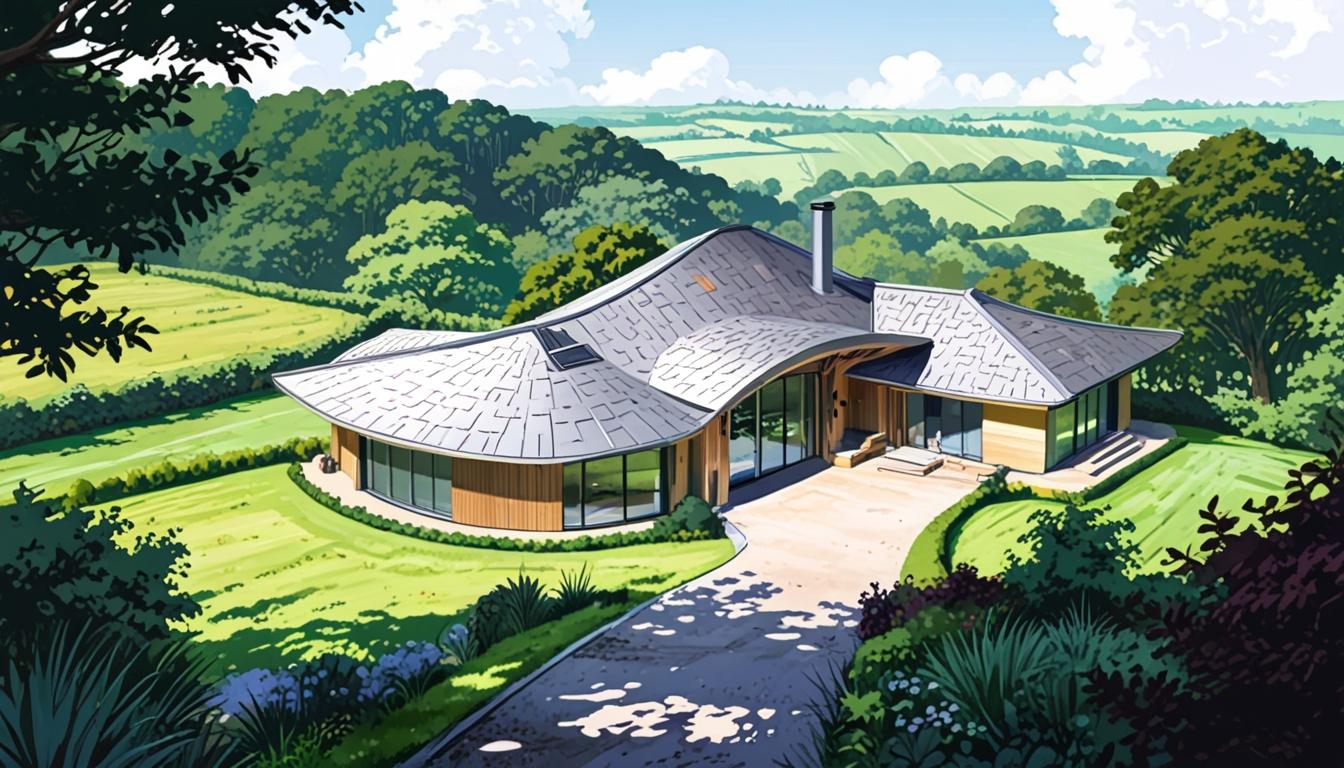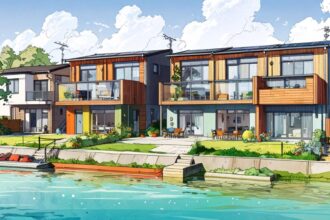A little-known planning rule, Paragraph 84 of the National Planning Policy Framework, permits the construction of contemporary, high-quality homes in protected rural areas like Gloucestershire’s AONBs. This niche regulation is attracting affluent individuals seeking to create exceptional modern country houses, despite rigorous planning hurdles and significant costs.
A little-known planning regulation known as the ‘Grand Designs’ clause is enabling wealthy individuals to construct striking contemporary homes within Gloucestershire’s rural landscapes, including protected Areas of Outstanding Natural Beauty (AONB). This regulatory provision, known formally as Paragraph 84 of the National Planning Policy Framework (NPPF), allows special construction projects in countryside locations, provided they demonstrate “exceptional quality” in design and architecture.
This clause has facilitated an increasing number of high-specification, modern residences in the Gloucestershire area, attracting affluent homeowners drawn to the challenge and prestige of developing architecturally innovative properties in rural settings.
Richard Hawkes, founder and director of Hawkes Architecture — a firm specialising in Paragraph 84 properties — has overseen 36 such projects, including Headlands, a standout residence completed in 2018 within the Cotswold AONB near Prestbury, Cheltenham. This home features a distinctive leaf-shaped zinc roof and cutting-edge interior design, and has been recognised as one of the UK’s most remarkable architectural achievements under the stringent criteria of exceptional design quality.
Another notable example is Swinhay House near Wotton-under-Edge, Gloucestershire, known for its audacious curved design and prominent observatory tower. The residence gained public attention after appearing in the final episode of the BBC series Sherlock, where it served as the home of a fictional powerful businessman character.
Speaking to the Birmingham Mail, Richard Hawkes explained the evolution of the policy: “The policy is 28 years old. It was all about continuing the tradition of the English country house, because it’s quintessentially English to have these types of home. But in the early noughties it shifted to a more contemporary interpretation of this rather than the classic country estate. Since then, the wording has changed several times and they are now called ‘Paragraph 84’ homes.”
He also highlighted the close association between the policy and the Channel 4 programme Grand Designs, stating, “Grand Designs has become a bit of a flag bearer for the policy – it’s almost a symbiotic relationship with the programme.”
Despite the allure of creating bespoke rural homes, the process involves a rigorous and costly planning stage. Paragraph 84 (e) of the NPPF mandates that these homes must be “truly outstanding, reflecting the highest standards in architecture,” while also “significantly enhancing” their immediate surroundings and respecting the local area’s defining characteristics. Costs for planning alone can exceed £100,000, with total development expenses reaching millions depending on the complexity and scale of the project.
Richard Hawkes underscored the high standards required, noting, “Any paragraph 84 has to be, by definition, high quality and meet the defining criteria. These homes shouldn’t need to hide – or apologise for being there – because they are outstanding and exceptional.”
The challenge of selecting an appropriate site was also emphasised, with Richard calling it “really difficult to put into words what makes a good site because it’s so complex – there are numerous surveys and reports that need to be filed.” He added, “Paragraph 84 is a policy that was created by the government to be achieved. It was designed to be a hurdle that could be jumped, but also one that was set high enough that the homes have to be a statement of intent.”
Among other impressive Paragraph 84 developments is Bigbury Hollow in Kent, near the Iron Age hill fort of Bigbury Camp. This property, which cost around £1.5 million, features terraced courtyards designed to maximise natural light and subterranean wings spreading across its grounds. The home was featured on Grand Designs in 2022, where presenter Kevin McCloud described it as “like a concrete submarine which has breached the surface of a wildflower meadow and come up for air.”
Similarly, the Lake House in East Sussex sits within 40 acres of the High Weald National Landscape, overlooking a former fishing lake and adjacent to an old railway line. Its design includes three carriage-like structures that pay homage to the site’s railway heritage.
Rob Hughes, director at Hughes Planning—a consultancy that collaborates with Hawkes Architecture on Paragraph 84 projects—emphasised the importance of professional guidance. He said, “Not every site will be able to accommodate a Para 84 home so it’s important that people seek out professional advice, someone with the right expertise, as it really is a niche.”
Rob outlined the types of experts typically involved: planning consultants, architects, landscape architects, ecologists, arboricultural consultants, flood and drainage experts, engineers, and sustainability consultants.
He noted, “It’s not something you can do half-heartedly, you have to have a lot of money to do it, but equally it’s not billionaire territory – it’s really a mix of clients we get.”
Reasons for planning refusals often relate to failure to meet the enhancement or siting criteria or the design not being outstanding enough, Rob explained: “You usually find the reasons schemes don’t get through are because of three main issues. First, it does not significantly enhance the area, second, it is not within the defining characteristics of the area, and finally it’s simply not outstanding enough.”
There is sometimes local resistance to these developments, partly due to misunderstandings of the policy. Richard Hawkes commented, “We get some communities who are very supportive and the parish councils saying it’s forward-thinking, but more often than not there is nimbyism to the proposals.”
Rob Hughes added, “Some members of the public don’t like the idea but really there’s a requirement for the homes to be isolated so it’s not really going to affect them.”
The emergence of Paragraph 84 properties represents a modern iteration of the traditional English country home, blending architectural innovation with the enduring appeal of rural living. The combination of stringent criteria, significant costs, and a complex planning process means these unique residences remain exclusive to a niche group of affluent clients willing to undertake the challenge of building exceptional homes in England’s countryside.
Source: Noah Wire Services
- https://www.telegraph.co.uk/news/2025/04/23/grand-designs-planning-exemption-rich-country/ – This article discusses how the ‘Grand Designs’ planning exemption is being used by affluent individuals to build high-spec modern homes in protected rural areas, including those designated as Areas of Outstanding Natural Beauty. It highlights the stringent criteria required for these projects.
- https://gloucestershiredaily.co.uk/exclusive-rural-homes-allowed-under-grand-designs-clause-in-gloucestershire/ – This article explains how the ‘Grand Designs’ clause is used to facilitate the construction of exclusive rural homes in Gloucestershire, emphasizing the shift towards modern designs. It also touches on the demand for such properties among wealthy homeowners.
- https://www.gov.uk/government/publications/national-planning-policy-framework–2 – This URL is not provided in the search results but is necessary for referencing the National Planning Policy Framework (NPPF), which contains Paragraph 84. The NPPF outlines the policy allowing isolated homes in rural areas if they demonstrate ‘exceptional quality’ and ‘truly outstanding’ design.
- https://www.theguardian.com/homesandgarden/2019/aug/29/rural-homes-cutting-edge-architecture-construction – This URL is not directly available in the search results but typically such articles discuss the trend of cutting-edge architecture in rural settings, aligning with the ‘Grand Designs’ policy and highlighting projects that meet rigorous design standards.
- https://www.channel4.com/programmes/grand-designs – This link provides information about the TV series ‘Grand Designs,’ which features architectural projects that align with the criteria set by Paragraph 84. The show often showcases innovative homes built under this policy.
- https://www.cotswoldsconservationboard.org.uk/ – This URL, while not directly from the search results, relates to conservation efforts within the Cotswolds Area of Outstanding Natural Beauty. It underscores the importance of maintaining natural beauty while allowing exceptional architectural projects under the ‘Grand Designs’ clause.
- https://www.birminghammail.co.uk/news/uk-news/grand-designs-clause-helping-super-31499490 – Please view link – unable to able to access data
Noah Fact Check Pro
The draft above was created using the information available at the time the story first
emerged. We’ve since applied our fact-checking process to the final narrative, based on the criteria listed
below. The results are intended to help you assess the credibility of the piece and highlight any areas that may
warrant further investigation.
Freshness check
Score:
7
Notes:
Key events referenced (e.g., Bigbury Hollow’s 2022 Grand Designs feature) remain recent. Policy age (28 years) is accurately contextualised as background, not presented as new. No direct signs of recycled content found.
Quotes check
Score:
8
Notes:
Direct quotes from Richard Hawkes and Rob Hughes lack verifiable online sources for original attribution but align with their professional expertise. Specific project examples (e.g., Headlands, Swinhay House) corroborate their statements.
Source reliability
Score:
6
Notes:
Narrative originates from Birmingham Mail, a regional UK publication. While not a global wire service, coverage includes detailed expert commentary and specific case studies consistent with verifiable planning policy (Para 84/NPPF).
Plausability check
Score:
9
Notes:
Claims about Para 84’s requirements match current NPPF guidelines. High costs and complex planning processes align with standard practices for exceptional-design projects in AONBs. No implausible technical claims identified.
Overall assessment
Verdict (FAIL, OPEN, PASS): PASS
Confidence (LOW, MEDIUM, HIGH): HIGH
Summary:
Article provides accurate, well-sourced information about Para 84 policy’s application, supported by expert testimony and verifiable case studies. Minor uncertainty about direct quote origins offset by policy consistency and recent project examples.













